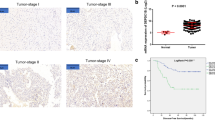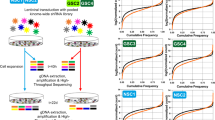Abstract
DEP domain containing 1 (DEPDC1) is a novel oncoantigen expressed in cancer cells, which presents oncogenic activity and high immunogenicity. Although DEPDC1 has been predicted to be a useful antigen for the development of a cancer vaccine, its pathophysiological roles in glioma have not been investigated. Here, we analyzed the expression and function of DEPDC1 in malignant glioma. DEPDC1 expression in glioma cell lines, glioma tissues, and brain tumor initiating cells (BTICs) was assessed by western blot and quantitative polymerase chain reaction (PCR). The effect of DEPDC1 downregulation on cell growth and nuclear factor kappa B (NFκB) signaling in glioma cells was investigated. Overall survival was assessed in mouse glioma models using human glioma cells and induced mouse brain tumor stem cells (imBTSCs) to determine the effect of DEPDC1 suppression in vivo. DEPDC1 expression was increased in glioma cell lines, tissues, and BTICs. Suppression of endogenous DEPDC1 expression by small interfering RNA (siRNA) inhibited glioma cell viability and induced apoptosis through NFκB signaling. In mouse glioma models using human glioma cells and imBTSCs, downregulation of DEPDC1 expression prolonged overall survival. These results suggest that DEPDC1 represents a target molecule for the treatment of glioma.






Similar content being viewed by others
References
Stupp R, Mason WP, van den Bent MJ et al (2005) Radiotherapy plus concomitant and adjuvant temozolomide for glioblastoma. N Engl J Med 352(10):987–996. doi:10.1056/NEJMoa043330
Gilbert MR, Dignam JJ, Armstrong TS et al (2014) A randomized trial of bevacizumab for newly diagnosed glioblastoma. N Engl J Med 370(8):699–708. doi:10.1056/NEJMoa1308573
Chinot OL, Wick W, Mason W et al (2014) Bevacizumab plus radiotherapy-temozolomide for newly diagnosed glioblastoma. N Engl J Med 370(8):709–722. doi:10.1056/NEJMoa1308345
Stupp R, Wong ET, Kanner AA et al (2012) NovoTTF-100A versus physician’s choice chemotherapy in recurrent glioblastoma: a randomised phase III trial of a novel treatment modality. Eur J Cancer 48(14):2192–2202. doi:10.1016/j.ejca.2012.04.011
Lee J, Kotliarova S, Kotliarov Y et al (2006) Tumor stem cells derived from glioblastomas cultured in bFGF and EGF more closely mirror the phenotype and genotype of primary tumors than do serum-cultured cell lines. Cancer Cell 9(5):391–403. doi:10.1016/j.ccr.2006.03.030
Singh SK, Hawkins C, Clarke ID et al (2004) Identification of human brain tumour initiating cells. Nature 432:396–401. doi:10.1038/nature03031.1.
Singh SK, Clarke ID, Terasaki M et al (2003) Identification of a cancer stem cell in human brain tumors. Cancer Res 63(18):5821–5828. doi:10.1038/nature03128
Fukaya R, Ohta S, Yamaguchi M et al (2010) Isolation of cancer stem-like cells from a side population of a human glioblastoma cell line, SK-MG-1. Cancer Lett 291(2):150–157. doi:10.1016/j.canlet.2009.10.010
Zhu Z, Khan MA, Weiler M et al (2014) Targeting self-renewal in high-grade brain tumors leads to loss of brain tumor stem cells and prolonged survival. Cell Stem Cell 15(2):185–198. doi:10.1016/j.stem.2014.04.007
Fukaya R, Ohta S, Yaguchi T et al (2016) MIF maintains the tumorigenic capacity of brain tumor-initiating cells by directly inhibiting p53. Cancer Res. doi:10.1158/0008-5472.CAN-15-1011
Ueda R, Iizuka Y, Yoshida K, Kawase T, Kawakami Y, Toda M (2004) Identification of a human glioma antigen, SOX6, recognized by patients’ sera. Oncogene 23:1420–1427. doi:10.1038/sj.onc.1207252
Ueda R, Ohkusu-Tsukada K, Fusaki N et al (2010) Identification of HLA-A2- and A24-restricted T-cell epitopes derived from SOX6 expressed in glioma stem cells for immunotherapy. Int J Cancer 126(4):919–929. doi:10.1002/ijc.24851
Takahashi S, Fusaki N, Ohta S et al (2012) Downregulation of KIF23 suppresses glioma proliferation. J Neurooncol 106(3):519–529. doi:10.1007/s11060-011-0706-2
Saito K, Iizuka Y, Ohta S et al (2014) Functional analysis of a novel glioma antigen, EFTUD1. Neuro Oncol 16(12):1618–1629. doi:10.1093/neuonc/nou132
Lollini P, Cavallo F, Nanni P, Forni G (2006) Vaccines for tumour prevention. Nat Rev Cancer 6(3):204–216. doi:10.1038/nrc1815
Kanehira M, Harada Y, Takata R et al (2007) Involvement of upregulation of DEPDC1 (DEP domain containing 1) in bladder carcinogenesis. Oncogene 26(44):6448–6455. doi:10.1038/sj.onc.1210466
Obara W, Ohsawa R, Kanehira M et al (2012) Cancer peptide vaccine therapy developed from oncoantigens identified through genome-wide expression profile analysis for bladder cancer. Jpn J Clin Oncol 42(7):591–600. doi:10.1093/jjco/hys069
Kassambara A, Schoenhals M, Moreaux J et al (2013) Inhibition of DEPDC1A, a bad prognostic marker in multiple myeloma, delays growth and induces mature plasma cell markers in malignant plasma cells. PLoS ONE 8(4):e62752. doi:10.1371/journal.pone.0062752
Miyata Y, Kumagai K, Nagaoka T et al (2015) Clinicopathological significance and prognostic value of Wilms’ tumor gene expression in colorectal cancer. Cancer Biomark 15:789–797. doi:10.3233/CBM-150521
Yuan S-G, Liao W-J, Yang J-J, Huang G-J, Huang Z-Q (2014) DEP domain containing 1 is a novel diagnostic marker and prognostic predictor for hepatocellular carcinoma. Asian Pac J Cancer Prev 15(24):10917–10922. http://www.ncbi.nlm.nih.gov/pubmed/25605201
Stangeland B, Mughal AA, Grieg Z, Sandberg CJ, Langmoen IA (2015) Combined expressional analysis, bioinformatics and targeted proteomics identify new potential therapeutic targets in glioblastoma stem cells. Oncotarget. doi:10.18632/oncotarget.4613.
Sampetrean O, Saga I, Nakanishi M et al (2011) Invasion precedes tumor mass formation in a malignant brain tumor model of genetically modified neural stem cells. Neoplasia 13(9):784–791. doi:10.1593/neo.11624
Osuka S, Sampetrean O, Shimizu T et al (2013) IGF1 receptor signaling regulates adaptive radioprotection in glioma stem cells. Stem Cells 31(4):627–640. doi:10.1002/stem.1328
Harada Y, Kanehira M, Fujisawa Y et al (2010) Cell-permeable peptide DEPDC1-ZNF224 interferes with transcriptional repression and oncogenicity in bladder cancer cells. Cancer Res 70:5829–5839. doi:10.1158/0008-5472.CAN-10-0255
Sendoel A, Maida S, Zheng X et al (2014) DEPDC1/LET-99 participates in an evolutionarily conserved pathway for anti-tubulin drug-induced apoptosis. Nat Cell Biol 16(8):812–820. doi:10.1038/ncb3010
Denning DP, Hirose T (2014) Anti-tubulins DEPendably induce apoptosis. Nat Cell Biol 16(8):741–743. doi:10.1038/ncb3012
Ishikawa H, Imano M, Shiraishi O, Yasuda A (2013) Phase I clinical trial of vaccination with LY6K-derived peptide in patients with advanced gastric cancer. Gastric Cancer. doi:10.1007/s10120-013-0258-6
Suzuki H, Fukuhara M, Yamaura T et al (2013) Multiple therapeutic peptide vaccines consisting of combined novel cancer testis antigens and anti-angiogenic peptides for patients with non-small cell lung cancer. J Transl Med 11:97. doi:10.1186/1479-5876-11-97
Kono K, Mizukami Y, Daigo Y et al (2009) Vaccination with multiple peptides derived from novel cancer-testis antigens can induce specific T-cell responses and clinical responses in advanced esophageal cancer. Cancer Sci 100(8):1502–1509. doi:10.1111/j.1349-7006.2009.01200.x
Izumoto S, Tsuboi A, Oka Y et al (2008) Phase II clinical trial of Wilms tumor 1 peptide vaccination for patients with recurrent glioblastoma multiforme. J Neurosurg 108:963–971. doi:10.3171/JNS/2008/108/5/0963.
Mi Y, Zhang C, Bu Y et al (2015) DEPDC1 is a novel cell cycle related gene that regulates mitotic progression. BMB Rep 48(7):413–418
Acknowledgements
We thank Ms. Yuko Aikawa, Tomoko Muraki, and Naoko Tsuzaki (Department of Neurosurgery, Keio University School of Medicine) for technical assistance.
Funding
This research was supported by the Japan Society for the Promotion of Science Grants-in-Aid for Scientific Research (B), Grant Number 15K19979.
Author information
Authors and Affiliations
Corresponding author
Ethics declarations
Conflict of interest
The author(s) declare that they have no competing interests.
Electronic supplementary material
Below is the link to the electronic supplementary material.
Rights and permissions
About this article
Cite this article
Kikuchi, R., Sampetrean, O., Saya, H. et al. Functional analysis of the DEPDC1 oncoantigen in malignant glioma and brain tumor initiating cells. J Neurooncol 133, 297–307 (2017). https://doi.org/10.1007/s11060-017-2457-1
Received:
Accepted:
Published:
Issue Date:
DOI: https://doi.org/10.1007/s11060-017-2457-1




